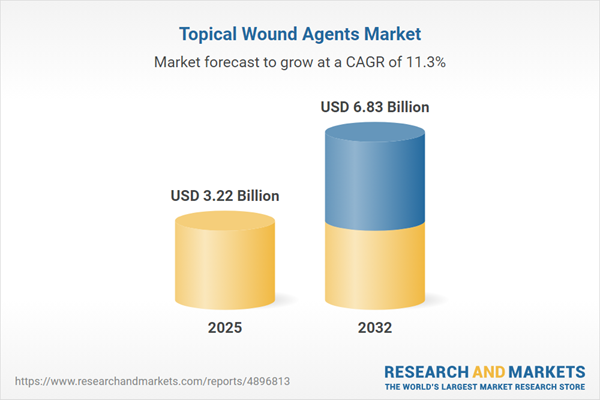Speak directly to the analyst to clarify any post sales queries you may have.
The topical wound agents market is adapting to constant change as healthcare organizations prioritize outcomes-driven care, product innovation, and integrated solutions. Senior stakeholders must access robust, actionable intelligence to realign procurement strategies and inform R&D in this evolving space.
Market Snapshot: Topical Wound Agents Market Size and Growth
The topical wound agents market is experiencing steady advances, with revenue projected to rise from USD 2.89 billion in 2024 to USD 3.22 billion in 2025, supported by an anticipated CAGR of 11.31% through 2032, ultimately reaching USD 6.83 billion. Drivers powering this market expansion include rapid product innovation, expanded healthcare investments, and a growing frequency of acute and chronic wound cases globally. Major healthcare buyers across both established and developing economies are reshaping their procurement and supplier selection to deliver more advanced wound care solutions, which is transforming market competition and strategic dynamics.
Scope & Segmentation
This analysis delivers targeted guidance for executive decision-makers, focusing on the segments, technology trends, and regions that underpin optimal strategy and market positioning.
- Product Types: Alginate, antimicrobial, collagen, film, foam, hydrocolloid, and hydrogel dressings support a spectrum of clinical needs, including exudate management, infection prevention, and tissue regeneration interventions.
- Wound Types: Acute wounds (surgical, traumatic) and chronic wounds (such as diabetic ulcers, pressure sores, venous leg ulcers) necessitate specialized formulations, each with distinct clinical application requirements.
- End Users: Hospital pharmacies, ambulatory centers, home healthcare providers, and specialty clinics base product selection on scale, operability, and the ability to optimize healing outcomes efficiently within different care environments.
- Distribution Channels: Hospital, retail, and online pharmacy networks play a central role in ensuring product accessibility and influencing procurement models across regions.
- Regional Coverage: The Americas, Europe, Middle East & Africa, and Asia-Pacific are included, with strategic spotlighting on countries such as the United States, Germany, China, India, Brazil, and South Africa, each reflecting unique regulatory and health system landscapes.
- Leading Companies: Organizations profiled include Smith & Nephew plc, 3M Company, Mölnlycke Health Care AB, ConvaTec Group plc, Coloplast A/S, B. Braun Melsungen AG, Johnson & Johnson Services, Inc., Paul Hartmann AG, Baxter International Inc., and Becton, Dickinson and Company, providing clear insights into innovation, product pipelines, and emerging competitive strategies.
Key Takeaways for Senior Decision-Makers
- Antimicrobial dressings featuring novel nanoparticles and bioengineered scaffolds are beginning to alter clinical protocols for a wide range of wound types.
- Collaborative R&D—often between biotech firms and research institutions—is resulting in dressings that deliver treatments directly to the wound site, supporting precision medicine initiatives in wound care.
- Digital health integration, such as remote wound monitoring and telemedicine, is increasing access to care and providing solutions for areas with limited wound care providers.
- Evolving regulatory requirements are facilitating shorter approval timelines for combination wound care products and are inviting competition from innovative market entrants.
- Agility in supply chain management is now crucial, prompting companies to reconfigure sourcing and production approaches to withstand uncertain input costs and ongoing supply disruptions.
Tariff Impact on Market Dynamics and Strategy
Recent tariff changes in the United States targeting imported wound care components and raw materials are significantly impacting manufacturer sourcing strategies within the topical wound agents market. Industry participants are placing greater emphasis on developing resilient domestic supply chains and actively pursuing alternatives to previously sourced materials. These shifts are fostering broader industry collaborations to maintain pricing stability, secure consistent supply, and provide reliable access for healthcare institutions amidst market disruption.
Methodology & Data Sources
This report synthesizes in-depth interviews with industry leaders and clinical specialists, integrated with thorough research from academic publications, regulatory archives, and public records. Rigorous quantitative analysis is applied to uncover growth factors and validate structural market trends, with external expert review ensuring the accuracy and reliability of findings.
Why This Report Matters
- Enables healthcare leadership to proactively identify areas of market growth and align with evolving regulatory and technology trends in advanced wound care.
- Provides actionable insights for both entering new geographical regions and expanding within target segments where differentiation and scalability matter most.
- Assists procurement and innovation leaders in anticipating disruptions, forming strategic partnerships, and investing in resilient, next-generation wound care technologies.
Conclusion
This comprehensive report equips healthcare executives with timely, validated insight designed to inform market-responsive decisions. Leverage its strategic findings to build organizational adaptability and drive innovation in topical wound agent solutions.
Additional Product Information:
- Purchase of this report includes 1 year online access with quarterly updates.
- This report can be updated on request. Please contact our Customer Experience team using the Ask a Question widget on our website.
Table of Contents
3. Executive Summary
4. Market Overview
7. Cumulative Impact of Artificial Intelligence 2025
List of Figures
Samples

LOADING...
Companies Mentioned
The key companies profiled in this Topical Wound Agents market report include:- Smith & Nephew plc
- 3M Company
- Mölnlycke Health Care AB
- ConvaTec Group plc
- Coloplast A/S
- B. Braun Melsungen AG
- Johnson & Johnson Services, Inc.
- Paul Hartmann AG
- Baxter International Inc.
- Becton, Dickinson and Company
Table Information
| Report Attribute | Details |
|---|---|
| No. of Pages | 195 |
| Published | October 2025 |
| Forecast Period | 2025 - 2032 |
| Estimated Market Value ( USD | $ 3.22 Billion |
| Forecasted Market Value ( USD | $ 6.83 Billion |
| Compound Annual Growth Rate | 11.3% |
| Regions Covered | Global |
| No. of Companies Mentioned | 11 |









